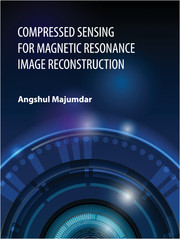Book contents
- Frontmatter
- Contents
- List of Figures
- List of Tables
- Foreword
- Preface
- Acknowledgements
- 1 Mathematical Techniques
- 2 Single Channel Static MR Image Reconstruction
- 3 Multi-Coil Parallel MRI Reconstruction
- 4 Dynamic MRI Reconstruction
- 5 Applications in Other Areas
- 6 Some Open Problems
- Index
- About the author
- Color Plates
2 - Single Channel Static MR Image Reconstruction
Published online by Cambridge University Press: 05 June 2016
- Frontmatter
- Contents
- List of Figures
- List of Tables
- Foreword
- Preface
- Acknowledgements
- 1 Mathematical Techniques
- 2 Single Channel Static MR Image Reconstruction
- 3 Multi-Coil Parallel MRI Reconstruction
- 4 Dynamic MRI Reconstruction
- 5 Applications in Other Areas
- 6 Some Open Problems
- Index
- About the author
- Color Plates
Summary
Magnetic Resonance Imaging (MRI) is a versatile medical imaging modality that can produce high quality images and is safe when operated within approved limits. X-ray Computed Tomography (CT) produces good quality images but is harmful owing to the ionizing radiation. On the other hand, ultrasound is safe, but the images are of very poor quality. The main challenge that MRI faces today is its comparatively long data-acquisition time. This poses a problem from different ends. For the patient, this is uncomfortable because he/she has to spend a long period of time in a claustrophobic environment (inside the bore of the scanner) – thus there is always the requirement of an attending technician to look after the patient's comfort. To make matters worse, the scanner is very noisy owing to the periodic switching on and off of the gradient coils.
However, patient discomfort is not the only issue. As the data acquisition time is long, any patient movement inside the scanner results in unwanted motion artifacts in the final image; some of these movements are inadvertent, such as breathing. Even these small movements may hamper the quality of images.
It is not surprising that reducing the data acquisition time in MRI has been the biggest challenge for the past two decades. The work is far from complete. Broadly speaking there are two approaches to reduce the data acquisition/scan times – the hardware-based approach and the software-based approach. Initial attempts to reduce the scan time were hardware-based methods where the design of the MRI scanner had to be changed in order to acquire faster scans. The multichannel parallel MRI technique is the most well-known example of this exercise. Unfortunately, research and implementation of hardware-based acceleration techniques were expensive and time-consuming; this is obvious as new scanners had to be designed, built, and tested. Moreover, the collateral damages caused by such hardware-based acceleration techniques were not trivial. For example, multichannel parallel MRI has been around for about 20 years. Reconstructing images from such scanners requires knowledge of sensitivity profiles of individual coils; this sensitivity information is never fully available. Therefore, reconstructing images from such parallel multichannel MRI scans remains an active area of research even today.
- Type
- Chapter
- Information
- Publisher: Cambridge University PressPrint publication year: 2015



